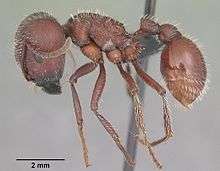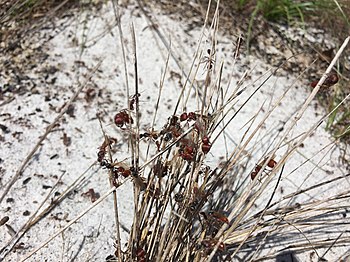Pogonomyrmex badius
Pogonomyrmex badius, or the Florida harvester ant, is a species of harvester ant in the genus Pogonomyrmex.[1] It is the only Pogonomyrmex species found on the east coast of the United States and the only one in North America known to be polymorphic.[2][3] The species is ubiquitous in the Florida scrub habitats.
| Pogonomyrmex badius | |
|---|---|
 | |
| Pogonomyrmex badius worker | |
| Scientific classification | |
| Kingdom: | |
| Phylum: | |
| Class: | |
| Order: | |
| Family: | |
| Subfamily: | |
| Genus: | |
| Species: | P. badius |
| Binomial name | |
| Pogonomyrmex badius (Latreille, 1802) | |
Biology
Colonies are near exclusively found nesting within well-drained sandy soils in xeric shrublands, grasslands, woodlands, and intact coastal dunes; being particularly partial to open areas with full sun.[4] The nests of mature colonies are very deep, usually 2.5 to 3.0 meters deep with seeds being stored about 40-100 cm in large flat granaries below ground.[5] On the surface the relatively flat mound is free of peripheral vegetation and is decorated with detritus and charred plant matter, the purpose of which is poorly understood. Alongside the nest also exists short foraging trails which extend into the surrounding area, usually in the opposite direction of any neighboring colonies.[6] Mature colonies are long lived and can persist for as long as 30 years.
Workers are highly polymorphic, ranging from 6.35mm for the smallest workers to 9.52mm for the largest majors which can rival the queen (10-12mm) in size.[7] Major workers are thought to aid in seed processing by milling seeds with their powerful mandibles.
Labor partitioning in the colony is organized spatially in respect to the vertical axis of the nest as a result of age polyethism. The youngest workers, which care for the brood and queen, reside in the deepest portions of the nest and as they age move closer to the surface and take up the typically more perilous activities of maintaining and defending the nest as well as foraging for food. The result is a division of the worker population along age demographics that's strongly stratified with depth.[8] Among harvester ants P. badius is unusual for its seasonal nest relocations, with colonies on average relocating once per year at a distance of 4-10 meters along an established foraging trail from the original nest site. New nests are rapidly excavated within a few days and vary little in architectural design.[9]
Seeds commonly harvested includes those of Paspalum setaceum, Dicanthelium commutatum, Croton michauxii and more; though seeds preferred are limited by size, as any seeds wider than 1-1.4mm cannot be cracked open by the workers.[5] Arthropod prey is also regularly taken, with a strong affinity for protein food items over the traditionally consumed seeds.
P.badius is preyed upon by relatively few animals - few well-known predators being the parasitoid eucharitid wasp Kapala floridana and the introduced Texas horned lizard, which thrives in Florida due to the stable populations of badius. These ants may also be infected by the deadly Myrmicinosporidium durum, a parasitic fungus which causes the integument to turn a nearly black color.
Reproduction

Colonies become reproductively mature at a population size greater than 700 workers and begin producing winged individuals around spring. Nuptial flights were observed from May to June most frequently in days of calm, sunny and humid mornings between the hours of 9 AM - 2 PM following a day of heavy rain. Female and male alates do not mate in the air and instead can be found mating at leks or at the surface of their natal nest with hundreds of excited workers accompanying them. During the excitement workers start to become aggressive towards alates that attempt to re-enter the nest, with alates either being forcibly evicted or denied entrance to the nest by workers.[10] [11]
The newly mated queens will fly off or walk some distance away from their parent nest to establish a new colony. True polygyny in the wild has never been observed, as excavated colonies were found to contain no more than one queen. Queens are fully claustral and do not venture out to feed when founding, instead solely relying on their fat reserves and wing muscles for sustenance.
Venom toxicity
Like most species belonging to the genus Pogonomyrmex, badius is equipped with a stinger capable of delivering a highly potent and painful neurotoxic venom adapted for defense against predatory vertebrates. [12] The venom of this species is considerably toxic, with a mice LD50 of 0·42 μg/g - comparable to the most toxic snake venoms. [13] Though the yield per sting is significantly low, multiple stings may prove dangerous to otherwise healthy individuals. Along with a few other Pogonomyrmex species, badius workers exhibit stinger autotomy in which the barbed stinger and venom sac is left embedded in the skin to continuously pump venom. The cost of this autotomy is the demise of the ant due to the internal damage from the stinger being pulled out, much like in Honey bees. [14]
References
- Bolton, B. (2015). "Pogonomyrmex badius". AntCat. Retrieved 30 January 2015.
- Cole, Arthur C (1968). Pogonomyrmex harvester ants. A study of the genus in North America. Knoxville, Tennessee: University of Tennessee Press. ASIN B0006BUR4W.
- "Florida harvester ant - Pogonomyrmex badius".
- https://www.antwiki.org/wiki/Pogonomyrmex_badius
- Tschinkel, Walter R.; Domínguez, Daniel J.; Pratt, Stephen C. (1 March 2017). "An illustrated guide to seeds found in nests of the Florida harvester ant, Pogonomyrmex badius". PLOS ONE. 12 (3): e0171419. doi:10.1371/journal.pone.0171419. PMC 5331987. PMID 28248988.
- Harrison, Janet S.; Gentry, John B. (1981). "Foraging Pattern, Colony Distribution, and Foraging Range of the Florida Harvester Ant, Pogonomyrmex Badius". Ecology. 62 (6): 1467–1473. doi:10.2307/1941503. ISSN 1939-9170.
- http://entnemdept.ufl.edu/creatures/urban/ants/harvester_ant.htm
- Tschinkel, Walter R. (2 July 2004). "The nest architecture of the Florida harvester ant, Pogonomyrmex badius". Journal of Insect Science. 4: 21. doi:10.1093/jis/4.1.21. PMC 528881. PMID 15861237.
- Tschinkel, Walter R. (19 November 2014). "Nest Relocation and Excavation in the Florida Harvester Ant, Pogonomyrmex badius". PLOS ONE. 9 (11): e112981. doi:10.1371/journal.pone.0112981. PMC 4237378. PMID 25409332.
- Smith, C. R.; Tschinkel, W. R. (23 October 2006). "The sociometry and sociogenesis of reproduction in the Florida harvester ant, Pogonomyrmex badius". Journal of Insect Science. 6 (32): 1–11. doi:10.1673/2006_06_32.1. PMC 2990325. PMID 19537980.
- https://www.jstor.org/stable/3495654?seq=1
- "Pogonomyrmex sting & venom". www.davidlouisquinn.com. Retrieved 2020-06-28.
- Schmidt, Justin O.; Blum, Murray S. (1978-01-01). "Pharmacological and toxicological properties of harvester ant, Pogonomyrmex badius, venom". Toxicon. 16 (6): 645–651. doi:10.1016/0041-0101(78)90192-7. ISSN 0041-0101.
- Hermann, Henry R. (1971-06-01). "Sting autotomy, a defensive mechanism in certain social Hymenoptera". Insectes Sociaux. 18 (2): 111–120. doi:10.1007/BF02223116. ISSN 1420-9098.